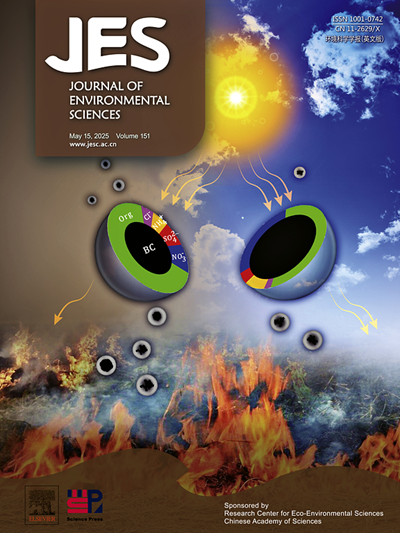Application of algal-mycelial pellets in the treatment of the mariculture wastewater
IF 6.3
2区 环境科学与生态学
Q1 ENVIRONMENTAL SCIENCES
引用次数: 0
Abstract
Hypersaline mariculture wastewater necessitates treatment prior to its discharge into marine environments. Algal-mycelial pellets (AMPs), known for their cost-effectiveness, energy efficiency and sustainability, have not been previously explored for their flocculation and pollutant removal capabilities in hyperhaline conditions. This work employed an orthogonal test design to investigate the effects of nine factors at three levels on the treatment efficiency of mariculture wastewater using Chlorella sp. TNBR1 and Aspergillus niger AMPs. The comprehensive optimal conditions for achieving the highest flocculation efficiency and pollutant removal are determined to be a temperature of 30 °C, light intensity of 6000 lux, a 12:0 light-dark cycle, an initial pH of 6, a microalgal density of 11.25 × 106 cell/mL, microalgal growth phase at the early logarithmic stage, a fungal spore density of 9.00 × 105 spore/mL and a fungal pellet phase of 60 h. Under such conditions, the treatment of nonsterile actual mariculture wastewater with Chlorella sp. TNBR1 and Aspergillus niger AMPs results in a 93.35 %±7.20 % reduction in chemical oxygen demand (COD), 92.83 %±7.29 % reduction in total nitrogen (TN), 100 % removal of total phosphorus (TP), and a flocculation efficiency of 69.21 %±5.36 %. These findings confirm that AMPs are a viable solution for effectively treating COD, TN and TP in real hypersaline mariculture wastewater, while also facilitating the flocculation and harvesting of microalgae.

藻丝球在海水养殖废水处理中的应用
高盐海水养殖废水必须在排放到海洋环境之前进行处理。藻类菌丝球(AMPs)以其成本效益、能源效率和可持续性而闻名,但此前尚未对其在高盐条件下的絮凝和污染物去除能力进行过探索。采用正交试验设计,研究了9个因素在3个水平上对小球藻TNBR1和黑曲霉AMPs处理海水养殖废水效果的影响。确定絮凝效率和污染物去除率最高的综合最优条件为:温度30℃,光照强度6000 lux,光暗循环12:0,初始pH = 6,微藻密度11.25 × 106 cells /mL,微藻生长期为对数初期,真菌孢子密度为9.00 × 105孢子/mL,真菌球团期为60 h。用小球藻(Chlorella sp. TNBR1)和黑曲霉(Aspergillus niger) AMPs处理非无菌实际海水养殖废水,化学需氧量(COD)降低93.35%±7.20%,总氮(TN)降低92.83%±7.29%,总磷(TP)去除率100%,絮凝效率为69.21%±5.36%。这些结果证实了AMPs是一种有效处理实际高盐海水养殖废水中COD、TN和TP的可行解决方案,同时也有利于微藻的絮凝和收获。
本文章由计算机程序翻译,如有差异,请以英文原文为准。
求助全文
约1分钟内获得全文
求助全文
来源期刊

Journal of Environmental Sciences-china
环境科学-环境科学
CiteScore
13.70
自引率
0.00%
发文量
6354
审稿时长
2.6 months
期刊介绍:
The Journal of Environmental Sciences is an international journal started in 1989. The journal is devoted to publish original, peer-reviewed research papers on main aspects of environmental sciences, such as environmental chemistry, environmental biology, ecology, geosciences and environmental physics. Appropriate subjects include basic and applied research on atmospheric, terrestrial and aquatic environments, pollution control and abatement technology, conservation of natural resources, environmental health and toxicology. Announcements of international environmental science meetings and other recent information are also included.
 求助内容:
求助内容: 应助结果提醒方式:
应助结果提醒方式:


